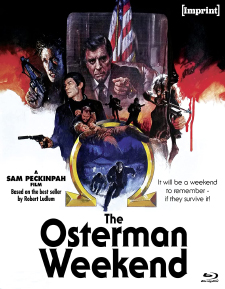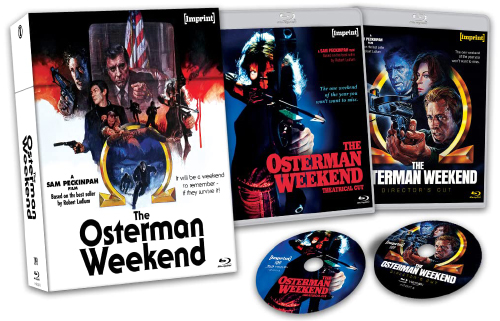Osterman Weekend, The (Blu-ray Review)

Director
Sam PeckinpahRelease Date(s)
1983 (April 8, 2022)Studio(s)
20th Century Fox (Imprint Films/Via Vision)- Film/Program Grade: C
- Video Grade: A-
- Audio Grade: B-
- Extras Grade: A
Review
[Editor's Note: This is a REGION-FREE Blu-ray release.]
The Osterman Weekend, a political thriller with themes of conspiracy and treachery based on Robert Ludlum’s second novel, is the last film directed by Sam Peckinpah (The Wild Bunch, The Ballad of Cable Hogue). An all-star cast is featured in this tale of revenge, paranoia, surveillance, and betrayal.
Lawrence Fassett (John Hurt) is an FBI field agent specially selected by agency head Maxwell Danforth (Burt Lancaster) to convince political TV host John Tanner (Rutger Hauer) to help in capturing a cabal of Russian terrorist sympathizers. Persuading Tanner to cooperate will not be easy. Three of the targets are Tanner’s closest friends—Osterman (Craig T. Nelson), Tremayne (Dennis Hopper), and Cardone (Chris Sarandon)—with whom he vacations once a year. These get-togethers are known as “Osterman weekends.”
Incredulous at first that his longtime buddies could be treasonous, Tanner eventually permits Fassett to bug his apartment to catch his friends in a compromising conversation during an upcoming gathering. Events spiral out of control and Tanner finds himself in the middle of a dark, insidious plan of vengeance that endangers lives.
The screenplay by Alan Sharp meanders and is short on suspense. Too much time is devoted to the uneventful personal lives of the large cast of characters, which slows the forward thrust of the narrative. Surprisingly for a Peckinpah film, dialogue dominates rather than action, apart from a car chase early on with appropriate mayhem. There’s a great deal of gratuitous nudity, starting with the first scene, which features a brutal murder. Shown under the opening credits, the scene is accompanied by a lush, sensual score by Lalo Schifrin—a jarring juxtaposition.
Violence overall is not as dominant as Peckinpah’s earlier output and the film lacks energy despite efforts by the cast to enliven it. Female cast members are mostly window dressing, though Meg Foster as Tanner’s wife has a sizable role and, wielding a crossbow, gets to be a crucial part of an important climactic scene. Hopper and Sarandon are wasted in their roles. Only Nelson gets considerable screen time and portrays a well-formed character.
Hurt is very good as the manipulative Fassett, whose allegiance is never quite clear. Hauer walks through the role of Tanner, never looking truly involved, even when the character's wife and child are in peril. He plays the part with a smugness and an air of superiority that distance him from the viewer. We’re supposed to root for him, but Hauer never makes Tanner accessible and vulnerable. As Danforth, Lancaster lends his star power, chiseled face, and authoritative voice to add considerable gravitas to the film, channeling his Gen. James Matoon Scott from Seven Days in May.
The Osterman Weekend cannot sustain suspense, even though danger rears its head as the film progresses. Peckinpah is far from his best, and with a mediocre script, he never elevates the material. It didn’t help that the producers took the film away from him and recut it to their liking, releasing something that, despite the quality of the material, wasn’t quite what he had originally delivered to them. Unfortunately, he’d never get a chance to make another film as he died of heart failure the year after the film’s release.
The Osterman Weekend was shot by director of photography John Coquillon with Panaflex cameras and Panavision lenses, finished photochemically, and presented in the aspect ratio of 1.85:1. Imprint Films brings the film to Blu-ray in several presentations. An older master has been used for the theatrical version of the film, presented in 1.78:1, while 2K scans of the theatrical version and the newly-rediscovered director’s cut are presented in 1.66:1. The color palette is varied, from the darkened rooms of Tanner’s house with illumination coming largely from surveillance screens to outdoor scenes in bright sunlight as the guests arrive at Tanner’s home and socialize around his pool. Details, such as patterns on clothes, video on the TV monitors, men’s facial stubble, and wood grain are nicely delineated. The screen images within the film are pre-HD and are not nearly as sharp as the rest of the footage. Complexions look natural. Clarity is sharp and blacks are deep and rich. Slow motion is used to enhance and prolong key scenes. An explosion at night is impressive. A car chase uses quick cutting to enhance excitement.
The audio is presented in English 2.0 Stereo LPCM (theatrical cut) and English Mono LPCM (director’s cut). On both versions, the sound is tinny and echo-y, and dialogue sounds murky. Only Burt Lancaster’s crisp enunciation comes through with clarity. The stereo effects in the theatrical version come to life only during a car chase, in which left-to-right and right-to-left action on the screen is nicely coordinated with sound. Sound effects, such as a helicopter, machine guns, cars skidding, engines racing, and men pummeling one another, come off better. Lalo Schifrin’s score is problematic, since it is often at odds with the visuals and works against mood rather than enhances it. Optional English SDH subtitles are also available.
The Osterman Weekend is presented in a 2-Disc Region-Free Limited Edition Blu-ray set in a clear amaray case with double-sided artwork featuring the US theatrical poster art signifying the “Theatrical Cut” on the front, and the Spanish and Italian theatrical poster art on the reverse signifying the “Director’s Cut.” Everything is housed within sturdy hardbox packaging featuring the UK and French theatrical poster art. The following bonus materials are included on each disc:
DISC ONE: THEATRICAL VERSIONS IN 1.78:1 AND 1.66:1
- Audio Commentary with Paul Seydor, Garner Simmons, David Weddle, and Nick Redman
- Alpha to Omega: Exposing The Osterman Weekend (78:05)
- Theatrical Trailer (2:52)
DISC TWO: DIRECTOR’S CUT IN 1.66:1
- Audio Commentary with Mike Siegel
- Passion and Poetry: Sam’s Final Cut (38:26)
- The Two Cuts: The Director’s Cut vs. Theatrical Cut (66:41)
- Filming The Osterman Weekend (9:46)
- The Osterman Weekend in 100 Pictures (9:45)
- Promoting The Osterman Weekend (9:40)
The theatrical version’s commentary has a meandering quality, with the quartet of film historians going off in all directions, seemingly unfocused. They discuss the screenplay and its flaws and comment that Sam Peckinpah was in poor health when he directed The Osterman Weekend. Their many anecdotes about Peckinpah portray him as talented, cantankerous, stubborn, opinionated, and willing to let actors try different things. They concur that The Osterman Weekend is “a cautionary tale of a visionary artist.”
In the director’s cut commentary, Peckinpah expert Mike Siegel discusses the differences between Peckinpah’s version and the theatrical version. A major difference is the opening scene, which Peckinpah purposely distorted visually so that it would appear to be a dream or nightmare. When his version was tested with a live audience, women hated it and there were several walk-outs. Taking a cue from test audiences, producers had the film re-edited to give it a better chance at the box office. Siegel goes into the behind-the-scenes politics, Peckinpah’s stubbornness, and his refusal to compromise his vision.
The feature-length documentary Alpha to Omega refers to The Osterman Weekend as the “final chapter” in Peckinpah’s career. The genesis of translating Robert Ludlum’s novel to the screen is documented. The producers had previously done modestly budgeted films. At the time, there was a willingness on the part of the studios to work with independent producers. Cast members discuss the film and how they got their parts. The primary location, which serves as Tanner’s home, was owned by actor Robert Taylor. Tension was built with the bonding company concerning costs and deadlines. A key theme is that TV is intrusive, manipulative, frightening and paranoia-inducing.
Passion and Poetry details that the director’s cut is the only 35 mm print in existence. It was made by Peckinpah archivist Don Hyde from Peckinpah’s own interlock negative in 1983. Hyde stored it for 14 years under perfect conditions but it ended up for the last 24 years in an unfavorable environment. While the colors survived in fine condition, the surface of the print started to dissolve years ago. With plans for future restoration, this 2K master was created by Mike Siegel in Germany after cleaning and slight color grading. Synchronizing the 11 reels of the original 35 mm magnetic mono soundtrack presented a bigger problem. Due to poor storage, reel 2 had shrunk and reel 1 was damaged beyond repair. The film was projected with a 1.66:1 aspect ratio in Europe and 1.85:1 ratio in the US. The unrestored 2K scan shows more information on all sides, eliminating just the visible microphones at the top of the frame. The Two Cuts is a comparison video, showing the differences between the two versions of the film.
Filming The Osterman Weekend consists of both black-and-white and color stills featuring the cast and crew during production. The Osterman Weekend in 100 Pictures is also a series black-and-white and color stills, with the film’s story unfolding in photographs. Promoting The Osterman Weekend features posters, lobby cards, and newspaper layouts used to market the film in the US, Japan, Italy, Finland, the UK, Mexico, and Spain. All of these image galleries are shown in slideshow format.
Sam Peckinpah has a distinct style that is definitely present in The Osterman Weekend. Yet despite slow motion, graphic violence, and considerable nudity, the film pales in comparison to hid earlier films. With its slow pace and dull character development, it never creates palpable suspense—a key ingredient of a thriller. The film is often confusing and occasionally incoherent. It looks as if Peckinpah was detached from the material and simply didn’t have enough interest to give it his best.
- Dennis Seuling


